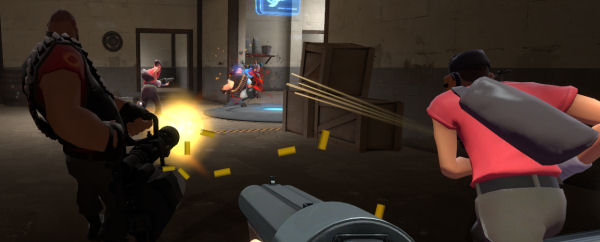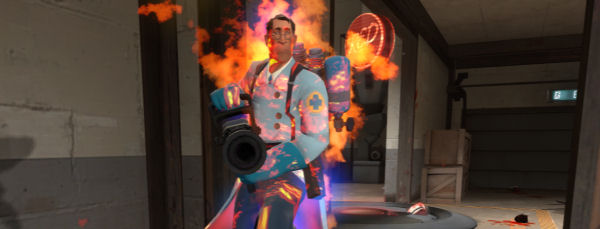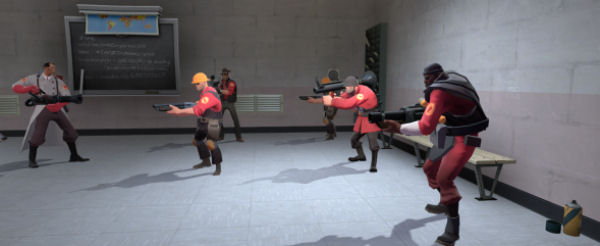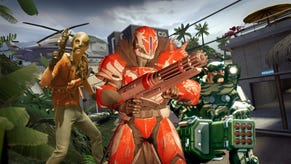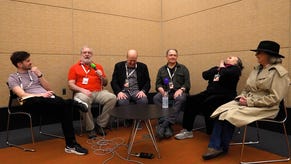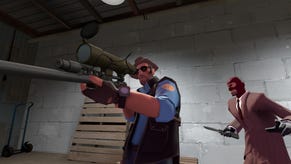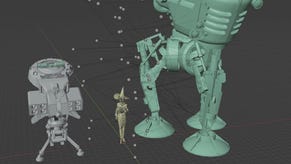RPS Exclusive: Team Fortress 2 Interview
In this first part of our two-part interview with Team Fortress 2 developers Robin Walker and Charlie Brown, we talk about the pathways from the modding community to working at Valve, the long development of TF2 and the changes it went through, Valve's thoughts on parallel mod Fortress Forever, and how the art design plays such a major role in how we play the game. In Part Two we get into specifics over the nine classes, how it was only by being funny that they were able to finish the game, and, inevitably, talk about Peggle.
TF2 developers Robin Walker and Charlie Brown are an excellent double act. Robin Walker talks, lots. Charlie Brown talks rarely. But despite this disparity, they gel neatly together, finishing each other's sentences (it’s just that Charlie finishes with a word, and Robin with another couple of paragraphs). Both represent an aspect of the ways Valve is different from any other gaming company I know of. Robin Walker, an original member of the Australian Team Fortress development team, still talks about himself as if he were a modder. He seems almost oblivious to his elevated position. Charlie Brown discusses coding in the way a quietly modest father might mention his pride for his son. Both talk about game development in terms of the player’s needs and desires. They still sound like gamers, perhaps in a large part because they, like every developer at Valve is required to, stay in constant communication with the people who play their games. And they seem to be enjoying themselves.
I began by asking Robin Walker how it was that the Team Fortress guys came to be working at Valve back in 1997. They were in demand at the time, their Quake-based mod attracting a lot of attention, with interest from Activision amongst others. But then Valve got in touch.
Robin Walker: Valve were interested in getting us to develop Team Fortress as a mod for Half-Life. They were a year away from releasing Half-Life 1. The big difference between Valve and everyone else was most people would email us and say, “Hey, what are you guys up to?” and we’d tell them, and they’d say, “Oh, that’s really interesting…” and we’d talk back and forth. With Valve, they sent us an email, we replied, and their first response was, “Here’s the plane tickets, get on the plane. Let’s go, no wasting time.”
RPS: And you got right to work?
RW: We had this laundry list of features we had that we wished we could have done in Quake. So we spent the first couple of months making Half-Life into a platform that was good to mod. We did that for a couple of months as contractors, and then Valve bought our company out, and we’ve been here ever since.
RPS: And it’s been a long time. What have you been doing since then?
RW: Oh, nothing.
RPS: Well.
RW: Well, we worked on TF2 a lot. We tried three or four different version of things we called TF2. And we all worked on Half-Life 2 and Episode One. Valve’s a small enough company that everyone works on everything. So it hasn’t been all TF2.
RPS: Did you ever feel you were trapped in a Duke Nukem Forever world of perpetually reinventing an idea?
RW: Not really. The arc of TF2 is something that’s probably familiar to a lot of amateur developers or designers. When we got here the first thing we built was overly complex, very hard core, almost impenetrable to anyone who wasn’t familiar with FPSs in general. And as we found as we played it, wasn’t more fun because of it. I think one of the things we’ve learned as designers over the time we’ve been here is to better preserve our ideas while still making them more understandable. We’re personally very proud that TF2 is the best product we’ve produced at doing this, where we don’t think we’ve sacrificed any of the depths or complexity that we wanted, but at the same time players can sit down in front of it and have fun without really understanding half of what’s going on. Most things that happen tend to be visually understandable at face value.
If I looked back at various designs in the different versions of TF2, then I think that’s the thing that moved the most. We were always doing interesting classes, interesting weapons, but I think the thing we succeeded at the most, that we were failing at the most, was that nugget of acceptability relative to depth.
RPS: That acceptability really struck me, prompting to write about how welcomed in I felt by the game. In contrast to this, I once had a two hour lesson in Counter-Strike and didn’t learn anything, other than it was incredibly hard.
RW: That was something we spent a heck of a lot of time on. All game developers will talk to you about the importance of that first thirty minutes, or hour, whether it’s a single or multiplayer game. The challenge with multiplayer is our inability to control the circumstances. You may join the server with 32 other snipers, or you might join a server where the admin doesn’t like the way we’ve made the game and he’s going to change a bunch of things, and so on – there’s a lot of areas out of our control. But we’ve really spent a lot of time on trying to make sure wherever we could that in visual and sound areas of the game it was up-front about what was going on. The obvious place where that occurred was in the visuals. We really built an art direction that was totally formed for the game. This was one of the advantages of the development taking so long. We really understood our game, so we knew the areas that the art direction had to be able to solve. I have a gun that shoots people and heals them, I have a guy that takes three times as much damage as this other guy…
Charlie Brown: Speed differences.
RW: Yeah, the incredible speed differences between two guys. We have nine different classes and it’s incredibly crucial that when one of them comes around the corner, you immediately know which one it is. And even if you don’t even know what the classes are, the shape and the way he moves should give you a sense of what he’s like, or what he does.
CB: Or that he’s different.
RW: Yeah, that he’s different than you. We were able to sit down and say, this has to be a world that encompasses these things. It was pretty obvious early on that the stylisation was going to help us a lot, but we wanted to try a bunch and find what worked. Even finding fictionalised background settings that aren’t important to players, but help us find a notion of the world we’re in, so that when you come to create the Spy’s cloaking device, you have an understanding of what this should be. Is it a large backpack he wears? Or is it a watch? Or is it a glowing neon stick?
CB: The art style solved so many problems. Things as simple as the Death Cam, letting people know what it was that happened to them, where it came from, so the next time they’re not taken by surprise. It’s one of the worst things in the world to walk out into a space, get nailed from somewhere, have no idea why, respawn and then have it happen again thirty seconds later.
RW: You’re not going to learn anything that way, you’re not going to get any better.
CB: There was no big one thing, but a thousand of little things came together.
RW: We’ve been building multiplayer games now for so long that we have an understanding of the first set of problems that any play-tester runs into. In any multiplayer game you play, there’s this batch of problems you always run into, and we made sure we addressed every one of those in TF2. You can regard any multiplayer game as a constant optimisation problem for players – they’re getting in and they’re going to try something, and they’re going to need to be told whether it worked or it didn’t. And then they’ll try something else, and they’ll need to be told again. And the more explicit and successful the game is at showing the cause and effect of any of your actions, the better you’re able to learn.
[I should probably mention that I was still in the room. It’s actually a real joy to be able to sit back and listen as two people enthuse so eloquently about their game. Robin continues.]
RW: Something to give you a sense of how much we work on this would be the weeks of work that go into the blood effect when you shoot someone. It does all these crazy levels of work. It scales differently – it doesn’t scale over distance like everything else does. It orientates itself perpendicular to the character you’re hitting, and deliberately moves outside the silhouette. So it sprays away from the character even if you shoot from the front. This is distance based. It doesn’t care too much when you’re up close to a character and it’s big on screen, but when you shoot from a distance it sprays to the side.
CB: It’s way more saturated, and a unique colour.
RW: The sound that the game plays attenuates differently so you’ll hear it at a greater distance. What we found was there was no magic bullet. It took fifty small things, and to be honest, it’s not perfect. But we are limited. When a player is focused they get a tunnel vision that’s so extreme that they’re literally focused at their crosshair level. But they’re looking past the HUD. You can’t put anything on the HUD at that point. Even if you put something on the crosshair, they don’t see it. They’re looking at the character they're shooting at.
This is all to explain how much work goes into the basics. Questions like, is my weapon hurting that character? Or am I hitting that guy? are so fundamental to the game’s effectiveness at talking to you about how effective your have been. If you screw that up, it doesn’t matter how many wonderful features we have at the meta-game level. I think this was a part of the problem we had with older versions of TF2. It doesn’t matter if you have this Commander class, and he has this magical strategy layer on top. When it gets down to it, if you screw up the way the game talks to you, it’s no good.
RPS: So has this all worked out as you hoped, going into the beta?
RW: We were… I don’t know if shock is quite the word, but definitely close to shock at how successful the beta has been in terms of response. We were never expecting to…
RPS: Take Steam down?
CB: That was one.
RW: [laughs]. Yeah, that was one thing. But also to dominate online spaces so effectively. We watch various places online to find out how we’re doing. Are we screwing up? That’s what we want to know. We get a lot of feedback on email, and forums, and comments online, and we gather as much of that as we can. The response to TF2 was more toward the positive than we were expecting. Anyone who’s shipped anything online will know you’re going to get a bunch of people who hate it, and a bunch of people who like it. And hopefully you have more people liking it than hating it. We were definitely expecting more complaints, I guess. [Laughs]. There were so many X factors. Like what were people expecting after ten years? I can’t remember half the stuff we were talking about and doing when we started TF2, so what’s the average TF2 fan at this point expecting it to be?!
RPS: Obviously whenever anything’s popular online, there’s a terrifying die-hard community. Have you had feedback from them? Have you managed to win them over?
RW: We’ve talked to them throughout the development. A year ago, after we announced the new visuals, a bunch of those guys talked to us over email. The sort of game they’re playing in Team Fortress Classic today is not the sort of game that 99 percent of TFC fans were playing then. I think they understood they weren’t our core for the types of people we were trying to get to play this. They’ve honed their skills to this razor-sharp degree that means if any of us were to go and play them, I’m sure they’d utterly destroy us. I hope those guys are having fun with TF2. I’ve had emails from some of them saying, “I was totally against this project. There was no way I was going to like it. But you’ve won me over.” So I hope those guys enjoy it. And if they don’t? Well, Fortress Forever’s really good! They can play that.
RPS: What do you think of Fortress Forever?
RW: I think they did a great job. We swapped emails, we tried to give those guys a bit of help. And hopefully we’ll get them up on into a Steam Friday update.
CB: They definitely did a lot of work. A lot of maps ported.
RW: I know how hard it is to get a bunch of people spread around the internet to finish anything. Let alone a product that’s good. I think those guys should be really proud of what they’ve managed to pull off. Personally, I hope they build something else now, and hopefully it’s their own. They’ve got a really good team.
RPS: Their timing couldn’t be much less fortunate, could it?
RW: That was purely accidental! As I say, we swapped emails with those guys. I’ve swapped emails with some of the developers, and I think we’ve all been embarrassed about the way all of our fans assume that we must hate each other or something. I wish we’d organised ourselves a little better. Everyone’s working, so no one’s paying a lot of attention to what anyone else is doing. But right out of the gate, I think they’re the biggest non-Valve mod, with the most players. They’re beating Gary’s Mod. I know that’s not traditionally a multiplayer game but it has a lot of players playing online at any point. They’ve done really well.
RPS: Shifting subjects, how does TF2 fit in with the design philosophy at Valve?
CB: I’d say it fits in pretty well. One of the things, technically, that we really wanted to do with the project was bring a lot of the knowledge that we had in the single player space into the multiplayer space. Like pacing, and things like that, which we spent a lot of time on in the single-player experience. Our multiplayer games haven’t really had that kind of pacing. TFC, its pacing while consistent, was flat. It wasn’t spiking as far as having a bunch of highs and lows, or building to a final crescendo. We wanted to capture that and bring it to multiplayer as best we could. Which was some of the ideology behind trying to avoid stalemates. We’ve put things in to try and break these moments, like invulnerability. Those ten seconds of invulnerability are really good at breaking this up, and changing the pace of the game. Everyone’s focused on fighting each other in a specific little battle, all of a sudden everybody is focused on a particular event.
RW: It’s a big spike in pacing for both the guys who went invulnerable – like, “Ooh! Charge!” – and it’s a big spike for the defenders. When an invuln crew comes in, you know you have to stay alive for ten seconds, and then you can push back. Defence, as Charlie says, is traditionally very stable. Guys come in, they push and you hold them. In defence, in fact, the goal is stability. Invulnerability breaks that. It’s, BAM, big moment for both offence and defence, and someone’s going to come out a winner and someone’s going to come out a loser. At the end of it, holding off an invulnerability charge is a big spike on the defence’s side. For the offence, it’s a big rallying cry. It’s a very explicit part of the crafting of the pacing.
CB: It follows through into general standings. We want the game to end on a higher moment. We don’t want it to just fizzle out. With our previous multiplayer games you can sit there for forty-five minutes just butting heads. Time runs out and you’ve finished the game with no real resolution. It’s not really satisfying for anybody. So, this notion of a stalemate was taken to another extreme with the Sudden Death mode. There is that kind of resolution one way or the other.
RW: We’re still working on the Sudden Death. I think, if anything, that sometimes stalemates more than we’d actually like too. So we have a couple of ideas for things that should make that even more rewarding for the teams.
RPS: In time for release?
RW: TF2’s a multiplayer project, and that means it’s not going to be “done”. We’re just going to keep working on it. Same as Counter-Strike had a lot of revisions over the years. With TF2 we intend to do the same. We’ve been releasing updates mostly focusing on fixes…
CB: Stability issues.
RW: We’re not marking the end of the beta, or the ship day, as a day that anything really changes. As a customer, you’ll be used to this. We already have various features we want to get out there, and we’ve got plans for the stat system.
Join us for Part Two of our interview with Robin Walker and Charlie Brown. Find out which are their own favourite classes, and which they avoid, learn more about their insatiable love of Peggle, and find out how it was the decision to be funny that finally brought us TF2 after a ten year wait. (And make sure to check back tomorrow for a special bonus surprise.) And - hell! - if you're here and have a hankering for all things TF2, you may enjoy our now complete Go Team! feature.



